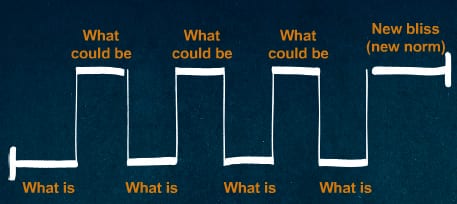Why does Every Pitch have a Problem Slide? (Walk-Through) – Summary
- Intro: Why Does Every Pitch Have a Problem Slide?
- The Secret to Audience Engagement
- How the Problem and Solution Help Your Pitch
- The Difference Between Problem Introductions in Investor Decks and Sales Decks
- How Not to Introduce Problems into your Sales Deck and Sales Pitch
- How To Introduce Problems into your Sales Deck and Sales Pitch
- Introducing the Solution
- Final Thoughts on Problem Development in your Pitch
- Wrap-up
Intro: Why Does Every Pitch Have a Problem Slide?
If you’ve done any research on what should go into your pitch deck, you may have noticed the problem slide coming up over and over again. In every great pitch, you will always see a problem slide and a solution slide, in one form or another.
There is a reason why we always have a problem slide in every pitch deck. It has to do a little bit with storytelling and how to put together the flow of a presentation. It also has to do with building an understanding of the current state and how bad it is without your solution and company.

The Secret to Audience Engagement
There’s a TED talk that you might have seen some number of years ago from Nancy Duarte about “The secret structure of great talks”. In her talk, she explains how the greatest orators in history have a very consistent pattern by which they talk about what they are presenting. That consistent pattern flows with human nature, helping the audience to follow along and be invested and interested in a presentation.
Duarte found that strong leaders, like Steve Jobs and Martin Luther King, for instance, use this approach in their presentations. The typical format they follow allows them to introduce positive and negative concepts. They then transition back and forth through these concepts all the way throughout their presentations.
Introducing the Negative
First, they talk about the negative situation. “It’s really bad in the world here today, here’s the situation”, and they paint that picture. Introducing the negative makes the current state case real and uncovers the pain that anyone in that situation must be feeling.
Shifting to the Positive
They then switch to the positive, happy future state. This future is aspirational. It paints a picture of what it’s going to be like; King’s “I Have a Dream…” or Job’s intro to the IPhone, for instance. In the case of your business it’s your solution and why you are here as a company. You are here making the world a better, problem free place for those who buy from you. Through that you make your customers happier and your investors money; and everyone is better off.
Integrating the Negative and Positive
Once they have introduced the positive and negative states and painted the pictures of both of those, they weave and transition back and forth from the negative to the positive, positive to the negative. Doing this keeps the audience engaged in a dance between what is and what might be. This allows emotional connections to be made and interest increases in bringing the solution to life. Investors bring solutions to life by investing and customers do it by buying.
How the Problem and Solution Help Your Pitch
And that is exactly why there is always a problem and a solution slide in every pitch deck. The problem = the negative. The solution = the positive. We introduce both in order to get our audience engaged and excited.
We want our pitch to draw the audience in. This shifting conversation between problem and solution or negative and positive creates dynamic storytelling. Engaging storytelling brings your audience along and gets them emotionally involved with your pitch. The more your audience connects with your story, the more invested and interested they become. If they are feeling the pain of that negative state, then they can more easily feel or imagine the relief of the positive side of it – the solution. Your awesome business, product or service, and team to the rescue!
The Difference Between Problem Introductions in Investor Decks and Sales Decks
Laying out a strong problem statement in your investor pitch and pitch deck is important. The reason we want strong problem statements is because we want to paint an objective picture of why our company should exist. It’s a story of how our strong solution will solve this painful problem, making our customers live happily ever after.
It’s slightly different when pitching to our customers directly through a sales deck or marketing message. Strong problem statements fit investor audiences better than customer audiences because investors are usually at least one step removed from the personal nature of actually having that problem. They can understand how your market might be feeling that problem but there’s little chance you are going to offend them in telling them someone else has this problem, it’s painful, and you’re here to solve it.

How Not to Introduce Problems into your Sales Deck and Sales Pitch
It’s a good idea to be cautious with a strong problem statement focus in your sales deck and sales presentations. When you are presenting to a customer audience, you don’t want to hit them really hard with the negative.
Don’t Start with the Solution
Start with the introduction of the problem first. Definitely don’t gloss over the problem with statements like “We have this really cool thing and lots of people are going to want to buy it, Yay!”. That’s what most bad marketing consists of. “Buy Now” and the like.
Don’t Hit Your Customers Head-on with “Their Problem”
Also, don’t tell them something super strong and direct like “It’s really bad, your life sucks”, right? That’s not going to work or feel good to your audience. Your chance of putting them on the defensive increases exponentially when you do this. “That’s not my problem.” This causes friction too early between you and your customer.
How to Introduce your Problem into your Sales Deck and Sales Pitch
When introducing your problem correctly, you want to help your customers see it more in terms of opportunity lost or maybe industry trends that are negative to their company. You also want to make sure you phrase the problem correctly and hit them indirectly with it instead of head-on. In this way, you can help remove them from the direct personal attack that might be implied or felt when making the negative state too much about them.
Use an Indirect Frame
When we introduce the problems in a sales or marketing instance, we need to frame problems in a less direct way. “There’s a problem. It exists in the world. It’s objective. It has numbers. There are humans that are having problems in this space.”
We’re just telling them a story about people who may or may not be them and how those people might be affected by it. We want to make sure what we’re saying doesn’t have to do with them personally. If they then choose to identify with the group you are talking about, it’s them making the choice, not you telling them or putting them in that box.
Make it Objective
Lay the problem out very clearly and objectively.”We can all agree humans have this problem, right?” Speaking objectively really helps to keep the audience’s emotional attachment low which in this case is important. You want to walk the line of creating emotion, but not raising resistance, denial, or anger about what you’re saying.

Introducing the Solution
Once we’ve accomplished presenting an effective, objective problem, the solution we are adding is basically saying, “Now that you agree there’s a problem and that humans have it, I have this solution”. It makes it a much easier to sell to your audience. They are much more open to that solution and in agreement with your stance on the problem. They might even want to know what the solution is because they are so bought into your perspective on the problem.
Final Thoughts on Problem Development in your Pitch
Framing your business around a problem is more effective than immediately framing around the solution. This is why the problem slide is the most common slide you’ll probably see in pitch decks.
Get to know your customer’s problems intimately. Help your company as a whole understand the problem and why your exist to solve it. When you are putting together your pitch deck or thinking about how you are going to go through your pitch, make the problem and solution stand out in stark contrast when pitching to investors. This will give them the ability to see the market potential and how valuable what you’re offering might be.
Think about “What is the problem that I am solving in the world?”
There’s definitely a problem out there. There’s probably a painful problem behind the origination of your business. Eliminating that pain is the reason why your customers want to buy what you are selling.
What is that pain? Go negative, paint that picture and help them feel the pain – but keep it objective as much as possible so your customers don’t get into denial mode. Help them understand that pain hurts, because that’s going to bring us to the reality of the current situation without you or your company.
Then tell them how it doesn’t have to be painful and how your solution eliminates their pain. Doing things in this order is going to make your investors and customers feel strongly about the current state before you even introduce the solution. Then you’ll be there to the rescue to make your customer’s lives the best they can be and your investors rich.
Wrap-up
We’d love to hear your thoughts and challenges you’ve had putting together your problem statement slide. Maybe why you think there shouldn’t be a problem slide – we’d love to hear your opinions. If you’ve done a sales presentation, what other approaches have you taken instead of a problem slide? Give us some examples. Let us know in the comments below.
If you have any questions, or you’d like to see me answer your question in an upcoming Pitch Hack video or Blog, go ahead and submit your ideas down below. We do videos and blogs every single week and I’d love to see you here again.
Happy Pitching!
Suggest an Upcoming Pitch Hack here: https://info.pitchdeckfire.com/pitch-hack-suggestions
For even more pitch hacks visit us here: https://resources.pitchdeckfire.com/tag/pitch-hacks
**Subscribe for more Pitch Hacks in your inbox every week**
Need help with your pitch? Pitch Deck Fire specializes in pitch deck design and presentation preparation. Sign up to speak to a project lead about your pitch deck, sign up here: https://pitchdeckfire.com/pitch-deck-project-initial-steps/
Seeking funding or preparing for a pitch? Find more resources, check out our other helpful articles and posts here: Resources.PitchDeckFire.com






